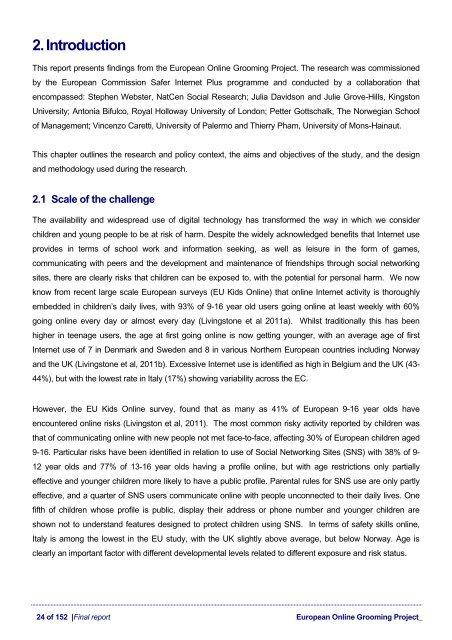Final Report - European Online Grooming Project
Final Report - European Online Grooming Project
Final Report - European Online Grooming Project
Create successful ePaper yourself
Turn your PDF publications into a flip-book with our unique Google optimized e-Paper software.
2. Introduction<br />
This report presents findings from the <strong>European</strong> <strong>Online</strong> <strong>Grooming</strong> <strong>Project</strong>. The research was commissioned<br />
by the <strong>European</strong> Commission Safer Internet Plus programme and conducted by a collaboration that<br />
encompassed: Stephen Webster, NatCen Social Research; Julia Davidson and Julie Grove-Hills, Kingston<br />
University; Antonia Bifulco, Royal Holloway University of London; Petter Gottschalk, The Norwegian School<br />
of Management; Vincenzo Caretti, University of Palermo and Thierry Pham, University of Mons-Hainaut.<br />
This chapter outlines the research and policy context, the aims and objectives of the study, and the design<br />
and methodology used during the research.<br />
2.1 Scale of the challenge<br />
The availability and widespread use of digital technology has transformed the way in which we consider<br />
children and young people to be at risk of harm. Despite the widely acknowledged benefits that Internet use<br />
provides in terms of school work and information seeking, as well as leisure in the form of games,<br />
communicating with peers and the development and maintenance of friendships through social networking<br />
sites, there are clearly risks that children can be exposed to, with the potential for personal harm. We now<br />
know from recent large scale <strong>European</strong> surveys (EU Kids <strong>Online</strong>) that online Internet activity is thoroughly<br />
embedded in children’s daily lives, with 93% of 9-16 year old users going online at least weekly with 60%<br />
going online every day or almost every day (Livingstone et al 2011a). Whilst traditionally this has been<br />
higher in teenage users, the age at first going online is now getting younger, with an average age of first<br />
Internet use of 7 in Denmark and Sweden and 8 in various Northern <strong>European</strong> countries including Norway<br />
and the UK (Livingstone et al, 2011b). Excessive Internet use is identified as high in Belgium and the UK (43-<br />
44%), but with the lowest rate in Italy (17%) showing variability across the EC.<br />
However, the EU Kids <strong>Online</strong> survey, found that as many as 41% of <strong>European</strong> 9-16 year olds have<br />
encountered online risks (Livingston et al, 2011). The most common risky activity reported by children was<br />
that of communicating online with new people not met face-to-face, affecting 30% of <strong>European</strong> children aged<br />
9-16. Particular risks have been identified in relation to use of Social Networking Sites (SNS) with 38% of 9-<br />
12 year olds and 77% of 13-16 year olds having a profile online, but with age restrictions only partially<br />
effective and younger children more likely to have a public profile. Parental rules for SNS use are only partly<br />
effective, and a quarter of SNS users communicate online with people unconnected to their daily lives. One<br />
fifth of children whose profile is public, display their address or phone number and younger children are<br />
shown not to understand features designed to protect children using SNS. In terms of safety skills online,<br />
Italy is among the lowest in the EU study, with the UK slightly above average, but below Norway. Age is<br />
clearly an important factor with different developmental levels related to different exposure and risk status.<br />
24 of 152 |<strong>Final</strong> report <strong>European</strong> <strong>Online</strong> <strong>Grooming</strong> <strong>Project</strong>_


